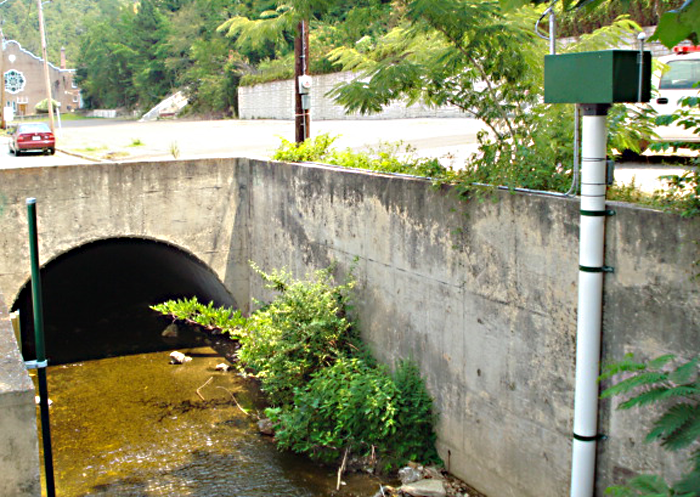


アーカンソー州ホット スプリングスは、ホット スプリングス国立公園に隣接する歴史豊かな都市です。この都市は山岳地帯、レクリエーション用の水路、45 を超える温泉に恵まれています。ホット スプリングス クリークは、町の中心部に湧き水を供給しています。1884 年にクリークは囲われ、クリークの上のアーチは現在、セントラル アベニューの土台となっています。周囲の山々は急峻な起伏があり、非多孔質の岩盤が広く露出しています。この水文学、地形、地質の組み合わせにより、都市のインフラストラクチャ、特にセントラル アベニューは、マイクロバースト降雨イベント時に洪水に非常に脆弱になっています。
2008 年以来、ホット スプリングス市は USGS アーカンソー水科学センターと協力し、同センターの洪水警報情報システムの維持と運用に取り組んでいます。このシステムは、市当局、緊急対応要員、地域の国立気象局事務所にタイムリーな洪水情報を提供する役割を果たしています。適切な警告があれば、急流救助隊を準備し、洪水が発生しやすい道路を封鎖し、低地の公共エリアから避難させることができます。
アーカンソー水科学センターは、ホット スプリングス市と年間契約を結び、システムの保守を行っています。USGS は、すべての機器を保守し、機能を検証し、流量モデルと水位と流量の関係を維持するために必要な流量測定を実施しています。
2013 年に洪水警報情報システムが更新されました。信頼性と機能性から、Campbell Scientific のハードウェアとソフトウェアが選ばれました。合計 9 つの計測ステーションとベース ステーションが改修され、さらに 2014 年に別のベース ステーションとカメラがシステムに追加されました。カメラにはパン、チルト、ズーム機能があり、緊急対応要員がリアルタイムで表示できます。
6 つのステーションは、水位と降雨量を報告します。各ステーションには、CR1000 データロガー、NL120 イーサネット インターフェイス、COM320 音声合成電話モデム、および GOES 衛星送信機が備えられています。データはインターネットと GOES システムを介して報告されます。警報は、テキストと対話型電話メッセージを介してステーションから直接送信されます。3 つのステーションは降雨量のみを報告します。各ステーションには、CR1000 データロガーと携帯電話データ モデムが備えられています。データはインターネットを介して報告され、警報は必要に応じて電子メールまたはテキスト メッセージで直接送信できます。
6 つの観測所で、CR1000 は SDI-12 レコーダーおよび SDI-12 センサーとして機能します。SDI-12 センサーとして、CR1000 は測定データを SatLink-V2 GOES DCP と共有します。GOES は冗長テレメトリ パスとして機能し、1 時間ごとに 15 分間のデータを USGS 国立水情報システムに提供します。2013 年に設置されて以来、このシステムは複数の高強度の短時間降雨イベントでテストされています。あるイベントでは、2 つの水位計で電源とインターネット サービスが失われましたが、GOES ランダム チャンネルを介した冗長通信により、データ配信は中断されませんでした。
2 つのベースは、Campbell Scientific の LoggerNet、RTMC Pro、および CSI Web Server ソフトウェアがインストールされたコンピュータで構成されています。さらに、ベースには NL120 と COM320 を備えた CR1000 データロガーがあります。ソフトウェアは、緊急要員がリアルタイム データを表示するための Web ページを含む、データ収集と表示に使用されます。RTMC Web ページは、ゲージの雨量と水位の値、雨水システムのレベル、および 48 時間の時系列ゲージ データを表示するように構成されています。ベース データロガーは冗長性を提供し、ベース コンピュータとは独立してインターネット経由でデータを収集します。ベース データロガーは、ゲージの高さまたは 1 時間あたりの雨量についてユーザー定義のしきい値に達すると、テキスト メッセージと対話型電話メッセージでアラームを発行します。主要要員にアラームを発することは、システムの最も重要な機能です。ベース ステーションは、通常の流量条件では、協力者に毎日の概要メールも送信します。
アーカンソー水科学センターは、キャンベル サイエンティフィックのトレーニングと技術サポートを受けて、ホット スプリングス市の洪水警報情報システムに必要な改善を実装しました。このシステムは、実際の暴風雨の状況下で、信頼性と柔軟性が向上していることがすでに実証されています。ホット スプリングス市の洪水警報システムの詳細については、次の Web サイトをご覧ください: ar.water.usgs.gov/hotsprings。